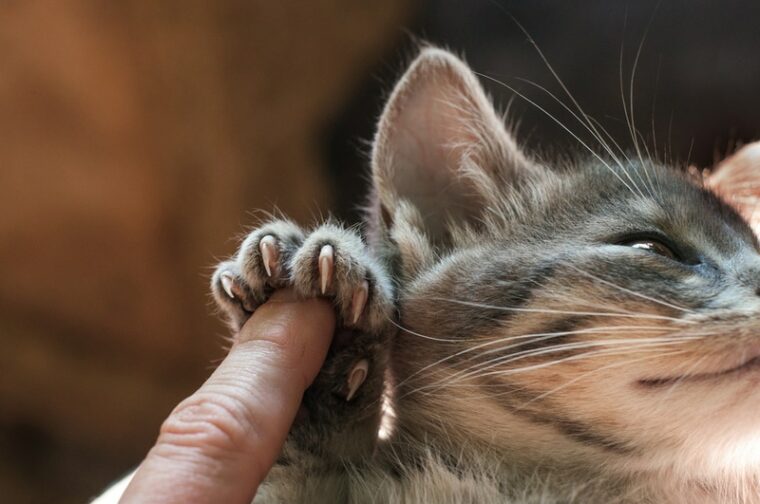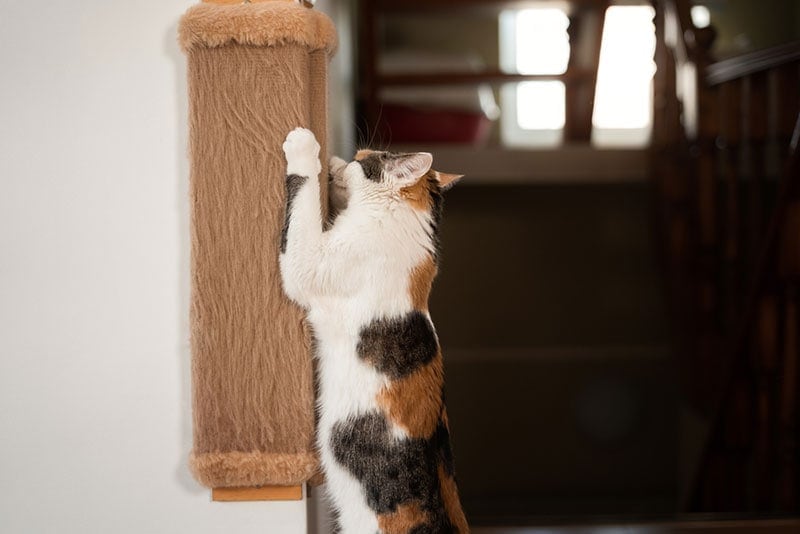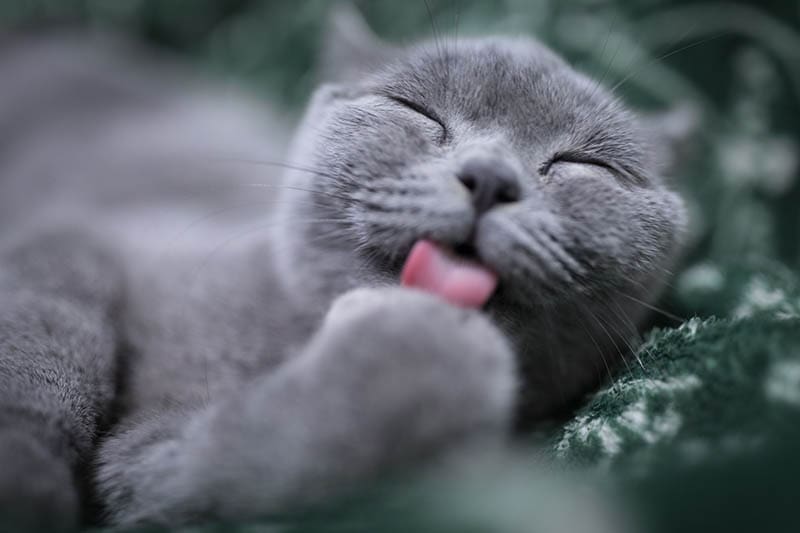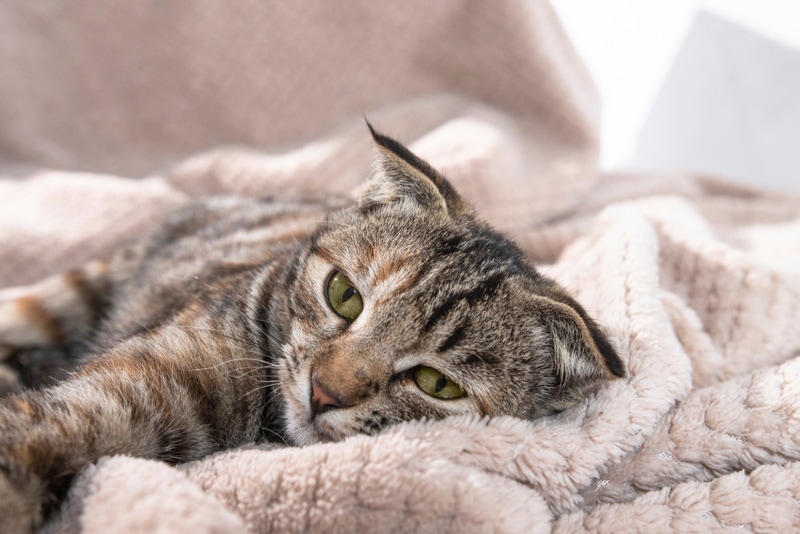
Click to Skip Ahead
Most cat owners will be familiar with the presence of tiny cat nails littered around their houses—stuck in the scratching post, on the sofa, and on the chairs. How did they get there? Why do cats shed nails? What does it mean when a cat’s nails split, and is there anything that can be done about it?
This article will answer all of those questions. Read on to find out the low down on why your cat’s nails might be splitting.
Anatomy of a Cat’s Nail
Cat’s nails are made up of the nail bed, which is a central area containing blood vessels and nerves. Around these delicate structures is a tough layer of keratin which forms a hard protective cover. The middle part of the nail is alive and the harder outer layer is dead.1
This explains why, when we clip the end of our cat’s nails, it is painless as it is dead material.
However, if we clip too much off and catch the nail bed, this is extremely painful and involves a high amount of blood loss if the vessels have been cut too.
The 9 Possible Reasons Why Your Cat’s Nails Are Splitting
1. Natural Shedding of the Nail
Cats all experience the natural shedding of their nails. This is a process where the whole of the sheath of the nail falls off to leave a new sharp nail underneath. This usually occurs every 2–3 months for healthy cats. This phenomenon occurs as the cat’s nails grow beyond the blood supply, the outer layer starts to crack and falls away leaving the new nail underneath. The new nail is strong and sharp.
Sometimes the old layer will naturally be shed, sometimes the cat will remove it forcefully when they are scratching things. There is no treatment for the natural shedding of nails as it is supposed to occur as part of the normal nail life cycle.

2. Aging Changes
As cats get older, the composition of their nails changes. They become full and brittle. Nails may become hard and thick and grow at strange angles. On top of this, older cats tend to have reduced mobility. This can be due to physical problems such as injuries and arthritis. It also can simply be because they are older and weaker so move about less, so their nails aren’t naturally worn down. They also may start going senile. This means they may forget to use their scratch posts leading to overgrown brittle, split nails.
Another issue with older cats is that often they haven’t had their claws clipped all their life, so when the time comes for intervention, they dislike their claws being clipped and will struggle. This is another good reason to start clipping their claws from a young age so that they are used to it. There is no treatment for aging changes.
3. Blunt Equipment Used
In an ideal world, cats will wear down their claws naturally without needing any assistance. However, some cats need help trimming their claws. This can be due to a reduction in mobility, old age, or an illness or injury. Either way, if claws are not kept short by the cat themselves, or by a human clipping them, they will grow into the pad. When this occurs, it is extremely painful, and infections can occur. Lots of owners like to clip their own cat’s claws to keep them short and to prevent this from happening.
Nail clippers are readily available from pet shops and online stores. There is a huge variation in the quality of different clippers. Some can be blunt or the wrong shape and this puts unnecessary pressure on the claw. This can cause the claw to become bent or misshapen which leads to split claws. Split claws can also become infected, so ensure the blades are always sharpened.
Keeping your cat's nails trimmed can help you avoid many common paw problems. We like Hepper's Cat Nail Clipper Set because it has it all: two sizes of well-designed clippers, a nail file, and a handy carrying pouch. The clippers have built-in safety guards and locking switches, and the blades are made of sturdy, easy-to-clean stainless steel.
At Pet Keen, we've admired Hepper for many years, and decided to take a controlling ownership interest so that we could benefit from the outstanding designs of this cool cat company!
4. Clipping Technique
If an incorrect technique is used during clipping, this can cause the nails to split too. If guillotine clippers are being used, ensure that the cutting blade angle lines up with the direction the cat’s claws follow. If these are used incorrectly, the nail will be crushed, and it will be extremely painful for the cat.
Your vet can cut your cat’s claws at the surgery, or they will be happy to demonstrate so that you can do it safely at home.
5. Nail Biting
Cats take their self-care very seriously. They will groom themselves multiple times a day and this grooming includes their paws and nails. Cats can actually gnaw through their nails and bite them off if the new nail is ready to come through underneath. This is all considered to be a normal part of their grooming routine, however chronic nail biting in cats is a problematic behavior.
There are various reasons cats might be drawn to bite their nails excessively. Infection, injury, stress, and anxiety can all contribute. Any sort of excessive biting or trauma to nails can cause them to crack and split. Treatment options involve identifying the underlying cause and addressing this. For example, antibiotics for infection or reducing and removing stressors in the cat’s environment.

6. Injury
Cats are very agile and can often be seen jumping on and off high surfaces and landing heavily. They are also usually good climbers and can get their claws caught when they are out and about. Any sort of injury involving their feet or toes can affect the claw and cause it to split. Treatment involves pain relief and appropriate management of injuries sustained.
7. Poor Nutrition
What your cat eats has a direct effect on the health of their nails. If they eat a well-balanced diet, with the correct amount of protein, carbohydrates, fats, vitamins, minerals, and fiber, they are likely to be in good health. If they are lacking in some nutrients, this will show in the condition of their body. Nails can become dry and brittle, and they can crack and split if they are in poor condition. If you are concerned about your cat’s diet and need some advice, your vet will be able to guide you.
8. Illness
There are various diseases and illnesses that can directly affect a cat’s nails.
Treatment options will be dictated by the specific disease process present. Infections will require antibiotics; endocrine issues have corrective therapies. Chemotherapy and radiotherapy options are available for some cancers.

9. Specific Nail Diseases
Treatment options depend on the underlying cause of these issues. There are often underlying health issues causing these clinical signs that need to be diagnosed. Antibiotics and anti-inflammatories can be used to combat infections and inflammation.
Why Are Split Nails Such a Problem?
If you see split or broken nails on your cat frequently, it is strongly advised that you take your cat to your vet to be seen. Not only are split nails extremely painful for your cat, but they also make the cat very prone to infections. If it is a chronic issue, your cat may even alter their gait when walking. This, in turn, can put undue strain on their legs and back. Split nails can be a sign of a serious problem, so it is always best to get it checked out with your vet.
Tips to Trim Your Cat’s Nails
This should be approached as a two-person job. One person should gently hold your cat and extend a leg forward. They should gently press on each toe to extract the nail. The other person should take some sharp, appropriately sized nail clippers and clip off the end of the nail, ensuring not to go close to the quick. Some cats tolerate it better if they are wrapped in a towel. It is normal for your cat not to tolerate all of their nails being clipped at first, do one foot at a time and build up slowly until they are more comfortable.
Conclusion
There are a number of reasons you may see your cat’s claws splitting. Some can be a normal part of their routine grooming and completely innocent. Some reasons are an indication of a chronic disease or a sign of something going wrong with your cat’s feet. If you start to see lots of claws splitting, you need to book an appointment with your vet to have your cat examined.
Featured Image Credit: Alonafoto, Shutterstock









